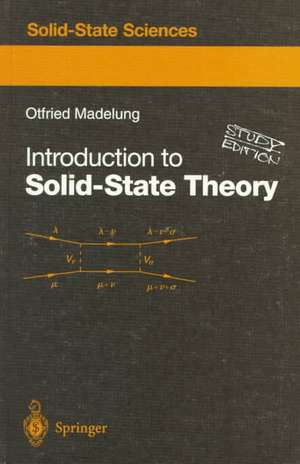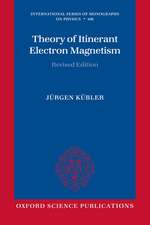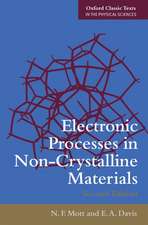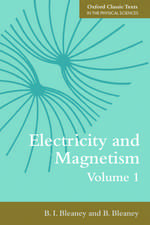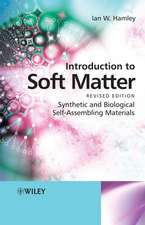Introduction to Solid-State Theory: Springer Series in Solid-State Sciences, cartea 2
Autor Otfried Madelung Traducere de B.C. Tayloren Limba Engleză Paperback – 17 noi 1995
Din seria Springer Series in Solid-State Sciences
- 18%
 Preț: 1225.94 lei
Preț: 1225.94 lei - 18%
 Preț: 1017.62 lei
Preț: 1017.62 lei - 15%
 Preț: 532.05 lei
Preț: 532.05 lei -
 Preț: 541.46 lei
Preț: 541.46 lei - 18%
 Preț: 962.35 lei
Preț: 962.35 lei -
 Preț: 385.84 lei
Preț: 385.84 lei - 18%
 Preț: 1827.48 lei
Preț: 1827.48 lei - 15%
 Preț: 661.02 lei
Preț: 661.02 lei -
 Preț: 389.88 lei
Preț: 389.88 lei - 15%
 Preț: 639.59 lei
Preț: 639.59 lei - 15%
 Preț: 635.15 lei
Preț: 635.15 lei - 18%
 Preț: 896.21 lei
Preț: 896.21 lei - 15%
 Preț: 647.92 lei
Preț: 647.92 lei - 15%
 Preț: 651.34 lei
Preț: 651.34 lei - 18%
 Preț: 890.23 lei
Preț: 890.23 lei - 15%
 Preț: 640.55 lei
Preț: 640.55 lei - 15%
 Preț: 649.54 lei
Preț: 649.54 lei - 15%
 Preț: 645.60 lei
Preț: 645.60 lei - 15%
 Preț: 644.30 lei
Preț: 644.30 lei - 15%
 Preț: 653.79 lei
Preț: 653.79 lei - 18%
 Preț: 956.69 lei
Preț: 956.69 lei - 15%
 Preț: 637.59 lei
Preț: 637.59 lei - 23%
 Preț: 1043.41 lei
Preț: 1043.41 lei - 15%
 Preț: 639.08 lei
Preț: 639.08 lei - 15%
 Preț: 648.24 lei
Preț: 648.24 lei - 15%
 Preț: 637.46 lei
Preț: 637.46 lei - 15%
 Preț: 640.06 lei
Preț: 640.06 lei -
 Preț: 391.40 lei
Preț: 391.40 lei -
 Preț: 390.84 lei
Preț: 390.84 lei - 15%
 Preț: 638.57 lei
Preț: 638.57 lei - 18%
 Preț: 1006.06 lei
Preț: 1006.06 lei - 18%
 Preț: 730.79 lei
Preț: 730.79 lei - 15%
 Preț: 640.37 lei
Preț: 640.37 lei - 15%
 Preț: 643.65 lei
Preț: 643.65 lei - 18%
 Preț: 1231.01 lei
Preț: 1231.01 lei - 18%
 Preț: 950.21 lei
Preț: 950.21 lei - 15%
 Preț: 642.68 lei
Preț: 642.68 lei - 15%
 Preț: 640.55 lei
Preț: 640.55 lei - 18%
 Preț: 1229.10 lei
Preț: 1229.10 lei - 15%
 Preț: 643.48 lei
Preț: 643.48 lei
Preț: 1391.67 lei
Preț vechi: 1697.16 lei
-18% Nou
Puncte Express: 2088
Preț estimativ în valută:
266.32€ • 276.36$ • 222.60£
266.32€ • 276.36$ • 222.60£
Carte tipărită la comandă
Livrare economică 18 martie-01 aprilie
Preluare comenzi: 021 569.72.76
Specificații
ISBN-13: 9783540604433
ISBN-10: 354060443X
Pagini: 504
Ilustrații: XI, 491 p.
Dimensiuni: 155 x 235 x 26 mm
Greutate: 0.75 kg
Ediția:1978
Editura: Springer Berlin, Heidelberg
Colecția Springer
Seria Springer Series in Solid-State Sciences
Locul publicării:Berlin, Heidelberg, Germany
ISBN-10: 354060443X
Pagini: 504
Ilustrații: XI, 491 p.
Dimensiuni: 155 x 235 x 26 mm
Greutate: 0.75 kg
Ediția:1978
Editura: Springer Berlin, Heidelberg
Colecția Springer
Seria Springer Series in Solid-State Sciences
Locul publicării:Berlin, Heidelberg, Germany
Public țintă
Professional/practitionerCuprins
1. Fundamentals.- 1.1 Introduction.- 1.2 The Basic Hamiltonian.- 1.3 The Hartree-Fock Approximation.- 2. The One-Electron Approximation.- 2.1 The Electron Gas Without Interaction.- 2.2 Electrons in a Periodic Potential.- 2.2.3 The Schrödinger Equation for Electrons in a Periodic Potential.- 2.2.5 Consequences of Translational Invariance.- 2.2.7 Wannier Functions, LCAO Approximation.- 3. Elementary Excitations.- 3.1 The Interacting Electron Gas: Quasi-Electrons and Plasmons.- 3.2 Electron-Hole Interaction in Semiconductors and Insulators: Excitons.- 3.3 Ion-Ion Interaction: Phonons.- 3.4 Spin-Spin Interaction: Magnons.- 4. Electron-Phonon Interaction: Transport Phenomena.- 4.1 The Interaction Processes.- 4.2 The Boltzmann Equation.- 4.2 Boltzmann Equations for the Electron and Phonon Systems.- 4.3 Formal Transport Theory.- 4.4 Transport in Metals and Semiconductors.- 5. Electron-Electron Interaction by Exchange of Virtual Phonons: Superconductivity.- 5.1 Introduction.- 5.2 Cooper Pairs.- 5.3 The Ground State of the Superconducting Electron Gas.- 5.4 Excited States.- 5.5 Comparison with Experiment.- 5.6 Thc Meissner-Ochsenfeld Effect.- 5.7 Further Theoretical Concepts.- 6. Interaction with Photons: Optics.- 6.1 Fundamentals.- 6.2 Electron-Photon Interaction.- 6.3 Phonon-Photon Interaction.- 7. Phonon-Phonon Interaction: Thermal Properties.- 7.1 Introduction.- 7.2 Frequency Shift and Lifetime of Phonons.- 7.3 The Anharmonic Contributions to the Free Energy, Thermal Expansion.- 7.4 The Thermal Conductivity of the Lattice.- 8. Local Description of Solid-State Properties.- 8.1 Localized and Extended States.- 8.2 The Chemical Bond.- 8.3 Local Versus Nonlocal Description in Unperturbed Lattices.- 9. Localized States.- 9.1 Point Imperfections.- 9.2 Localized States andElementary Excitations at Surfaces.- 10. Disorder.- 10.1 Localized States in Disordered Lattices.- 10.2 Transport in Disordered Lattices.- 10.2 The Hopping Probability.- Appendix: The Occupation Number Representation.- Problems to Chapters 1–9.
Recenzii
FROM THE REVIEWS:
ZEITSCHRIFT FUR PHYSIKALISCHE CHEMIE
"…the textbook is an excellent introduction into most fields of modern solid state theory and may be recommended to…graduate students in physics and material sciences as well as researchers in the field of solid state physics.”
PHYSICALIA
"…the book is remarkably well articulated and its organization is crystal-clear…Because this book requires a good-knowledge of quantum mechanics and also some prior knowledge of the most important solid-state phenomena, we shall recommend it to advanced graduate students or researchers, having already been introduced to the solid-state physics. They shall find in it a systematic introduction of the concepts of solid-state theory, presented in a unified way, that is illuminating from many points of view.”
ZEITSCHRIFT FUR PHYSIKALISCHE CHEMIE
"…the textbook is an excellent introduction into most fields of modern solid state theory and may be recommended to…graduate students in physics and material sciences as well as researchers in the field of solid state physics.”
PHYSICALIA
"…the book is remarkably well articulated and its organization is crystal-clear…Because this book requires a good-knowledge of quantum mechanics and also some prior knowledge of the most important solid-state phenomena, we shall recommend it to advanced graduate students or researchers, having already been introduced to the solid-state physics. They shall find in it a systematic introduction of the concepts of solid-state theory, presented in a unified way, that is illuminating from many points of view.”
Textul de pe ultima copertă
Introduction to Solid-State Theory is a textbook for graduate students of physics and materials science. It also provides the theoretical background needed by physicists doing research in pure solid-state physics and its applications to electrical engineering. The fundamentals of solid-state theory are based on a description by delocalized and localized states and - within the concept of delocalized states - by elementary excitations. The development of solid-state theory within the last ten years has shown that by a systematic introduction of these concepts, large parts of the theory can be described in a unified way. At the same time, this form of description gives a "pictorial" formulation of many elementary processes in solids, which facilitates their understanding.
